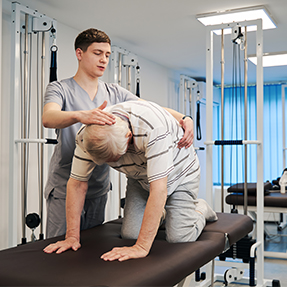
Bear crawl: Best compound exercise for full-body benefits
Bored with burpees, planks, and situps? Then consider doing the bear crawl. While it looks deceptively easy, this underrated core move is more challenging than it seems. The bear crawl move will unlock your core’s true potential as it works the entire body firing up muscles you forgot you had.
Commonly used in boot camp and Crossfit training, it’s important to know how to make this move properly to achieve its many benefits and to prevent injury. Depending on your fitness level, there are variations to fit your particular needs.
How to perfect doing a bear crawl
To properly execute a bear crawl, start in a push-up position. Your hands should be directly in line underneath your shoulders and your hips hip-distance apart with your heels off the floor – your knees will be lifted slightly, hovering over the ground. Once in this position, tighten your abs, keeping your back straight, flat, and strong. To help visualize keeping your back straight and flat, pretend you have a glass of water sitting on your lower back. Doing so will force your abs to tightly engage, helping take pressure off of your hips and arms as it stabilizes your body.
Also, be sure to keep your butt down. You do not want your butt higher than your shoulder blades while you make this move. You may notice that as you perform the exercise and become fatigued, your butt may begin to rise. Prevent this by flexing your abs hard while squeezing your glutes.
Once you are in the correct position for a bear crawl, here is the way you want to move along:
- Move forward by simultaneously moving your right hand and left leg in a crawling motion. Your knees never touch the ground.
- Switch sides immediately after placing weight on your right hand and left leg, moving your left hand and right leg forward.
- Continue in a crawling motion, moving forward.
Overall, the fundamental technique tips you need to perform this move correctly are the following:
- Keep your abs braced
- Make sure your hips/buttocks are down
- Keep your knees close to the floor
- Aim for a long, straight back
The many benefits of the bear crawl
Crawling along like a bear may not seem particularly tough, but try it and decide for yourself. Especially if you choose to crawl along varied terrain outdoors, you’ll notice right away it challenges your hips, thighs, abs, and other muscles. However, when done regularly, bear crawls can build total-body strength and endurance.
Here’s a look at the many benefits your body will thank you for and what to expect:
- Improves dexterity – Dexterity involves fine motor skills and hand-eye coordination.
- Improves agility – Agility is the ability of the body to move fast and be nimble, to change both the direction and positioning of the body while in motion. Performing exercises such as the bear crawl can help improve and enhance athletic performance.
- Boosts metabolism – By activating all of your muscles, the bear crawl increases metabolism initially and long-term builds muscle mass.
- Fires up cardio fitness – The bear crawl move will increase your heart rate as your body is challenged to keep up the pace.
- Creates a mental challenge – To perform the bear crawl correctly, you must always think about your position at all times. This makes you more aware of your body as your brain focuses on maintaining balance while keeping your limbs moving at once.
- No equipment is needed – All you need is YOU, and it can be done indoors or outside.
- You will gain benefits in less time – Lack of time is a common reason many avoid exercise. But compound exercises like the bear crawl solve this problem by helping you gain more benefits in less time.
- Improves stability and mobility – Stability and mobility are two fundamental factors in recovering from and preventing injury. Too little or too much movement and a lack of stability in the muscles and joints can lead to stiffness, dysfunction, and degenerative changes that can increase your risk of injury. Also, by intensely working your core muscles, you’ll gain better stability long-term. Your core muscles are meant to stabilize your spine all day, helping reduce back stiffness and pain.
Adding in other variations of the bear crawl
Once you’ve mastered the basic bear crawl, consider adding in other variations of this move for additional body benefits.
- Backward bear crawl – For this move, simply travel forward for a few yards, reverse the sequence, and travel backward.
- Sideways bear crawl – Starting in the same position as a regular bear crawl, instead of moving forward, simply move to the side. Make sure you move to both the left and right to work each side of your body evenly.
- Weighted bear crawl – To increase the challenge of the bear crawl, either wear a weighted vest or place a weight plate on your flat back while doing a forward bear crawl.
Dr. David Samadi is the Director of Men’s Health and Urologic Oncology at St. Francis Hospital in Long Island. He’s a renowned and highly successful board certified Urologic Oncologist Expert and Robotic Surgeon in New York City, regarded as one of the leading prostate surgeons in the U.S., with a vast expertise in prostate cancer treatment and Robotic-Assisted Laparoscopic Prostatectomy. Dr. Samadi is a medical contributor to NewsMax TV and is also the author of The Ultimate MANual, Dr. Samadi’s Guide to Men’s Health and Wellness, available online both on Amazon and Barnes & Noble. Visit Dr. Samadi’s websites at robotic oncolo gy and prostate cancer 911.
